Based In Science, Elevated by Service
Based In Science, Elevated by Service By Vessel Crew Vessel’s passion for improving the lives of others is anchored in an enthusiasm for science and its basis in wellness. Since our founding,…

By Vessel Crew
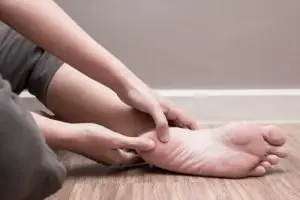
Plantar fasciitis is a widespread cause of heel pain and affects about 10% of the U.S. adult population. With such a high prevalence, it is important to understand the symptoms and causes of plantar fasciitis while also looking at what a plantar fasciitis diagnosis means and treatment options.
The plantar fascia is a long flat ligament on the bottom of your foot. It connects your heel bone to your toes to support the arch of your foot. Like other ligaments in your body, it can stretch within limits and then return to normal.
Foot Plantar fasciitis If too much tension and stress are applied, small tears can form in the fascia. When the condition is new or acute, it causes inflammation of the plantar fascia and is called plantar fasciitis. Of course, many people push through the discomfort. They rarely give the fascia enough time to properly heal, so the body patches the inflamed fascia with scar tissue.
Repeatedly doing this over months or years causes more tears and scar tissue, until your fascia is in a state of degeneration with chronic pain. Not only do you have an area of significant scar tissue now, but the blood vessels in that area are disorganized. These inhibit your body from healing the injury and causing chronic pain.
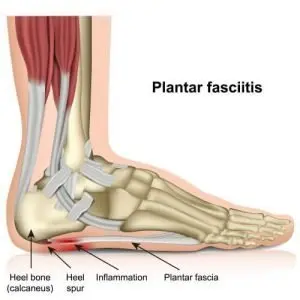

Help! My foot hurts!
If you have felt stabbing pain on the bottom of your foot when taking your first steps in the morning or during activities, then you know plantar fasciitis can be very painful.
You may feel a dull or sharp pain in your heel or the arch of your foot. It may also feel like the bottom of your foot is bruised with a deep ache.
The pain is usually worse when you first stand up after sitting, but it may start feeling better as you begin walking and warm up the fascia. These are common plantar fasciitis symptoms. We will talk next about the causes of plantar fasciitis.
Why does my foot hurt so much? Your feet take a pounding every day with the stress of every step, skip, and hop. The plantar fascia is a ligament in your foot shaped like a bowstring that connects your heel to your toes. It supports the arch of your foot and acts as a shock absorber while walking, running, stepping, and exercising.
Small tears form when there is too much tension on this bowstring. The repeated over-stretching of the plantar fascia causes irritation or tiny tears and leads to plantar fasciitis, the plantar fascia’s inflammation.

Plantar fasciitis is one of the most common injuries affecting millions of Americans. Understanding the common causes of plantar fasciitis and risk factors is essential to preventing it. If you are between the ages of 40-60 and are overweight, you are much more likely to develop plantar fasciitis.
Exercises and occupations that put excessive stress on your feet can also cause plantar fasciitis. For example, plantar fasciitis is prevalent in runners, nurses, mechanics, teachers, and other occupations that require much time on their feet. These risk factors, combined with foot mechanics and non-supportive footwear, are among the most common causes of plantar fasciitis.
Common Causes of Plantar Fasciitis:

Plantar fasciitis is most common in middle-aged and older adults between the ages of 40 and 60, affecting women slightly more than men. As you age, your feet may flatten, and you may notice a drop in your arch. With this change in foot mechanics, the plantar fascia becomes increasingly unable to absorb and distribute each step’s shock. It becomes stressed and small tears form.
When you are younger, the plantar fascia can quickly repair itself, and your feet can maintain a better arch. With age, the plantar fascia cannot preserve its shape as well, the bowstring relaxes, and your foot arch drops. This does not happen to everyone but is more prevalent with age.
Foot mechanics, the foot structure, is another common cause of plantar fasciitis affecting people of all ages. For people with naturally flat or even high arches, the plantar fascia may not effectively support the arch and absorb each step’s shock. Overpronation (foot rolls in), supination (foot rolls out), and abnormal walking patterns can affect weight distribution in your feet and put added stress on the plantar fascia.
Walking with a slight limp due to back, hip, or knee pain can affect your feet as well. For example, some people notice that their feet start feeling better after they treat a problem with their knees. A podiatrist may recommend a pair of orthotics to fit into your shoes for those with low arches. This helps support the foot, improve the foot mechanics, and improve plantar fasciitis symptoms.


Another common cause of plantar fasciitis is having a high body mass index or being overweight. The extra pounds put additional stress on not only your heart and joints but also on your feet. Since the plantar fascia is a shock absorber, the additional pressure applied in each step from extra weight requires the plantar fascia to absorb more shock. This additional stress and pounding on the feet are a prevalent cause of plantar fasciitis. There is a documented correlation between obesity and plantar fasciitis. Doctors often speak to their patients about the role of weight loss in plantar fasciitis treatment.
Certain types of exercise and occupations also lead to an increased risk of developing plantar fasciitis. Activities that put a lot of stress on your feet, such as long-distance running and ballet, commonly lead to plantar fasciitis. The same is true for jobs that require long periods of standing or walking. Teachers, nurses, mechanics, and other occupations that spend hours on their feet can often develop this painful condition. Whether it is due to exercise or work, these activities can easily overstress your plantar fascia and cause this painful condition.
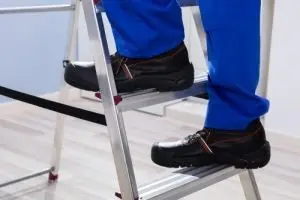

Your choice of footwear can put you at a higher risk of developing plantar fasciitis. Improper shoes put additional and/or unbalanced stress on your feet. The shape of your footwear and the type of footwear chosen for a prolonged activity can negatively affect your foot mechanics and lead to unneeded stress on the plantar fascia.
It is essential for runners that you have good shock absorbing shoes that support your arch and are frequently changed out based on your mileage. If you walk a lot as part of your job or stand for extended periods on hard surfaces like concrete, supportive cushioned shoes are necessary.
Sorry, high heels and flip flops are popular but are non-supportive shoes. High heels are not good because they put your feet in an unnatural position and cause uneven weight distribution. The lack of arch support and heel cushion can put excessive stress on your plantar fascia with flip flops.

Suppose you have experienced the plantar fasciitis symptoms listed above and are in a high-risk category. In that case, it is essential to see your family doctor or podiatrist. It would be best if you did not try to self-diagnose your pain as numerous other injuries have similar symptoms.
Doctors base their plantar fasciitis diagnosis on a physical exam and a review of your medical history. While examining your foot, locating the area of pain helps rule out other injuries like Achilles tendonitis. Your doctor might also recommend an X-ray or MRI to ensure that no other problem, such as a stress fracture or nerve entrapment, is a cause of your pain.
Depending on the length of time you have experienced plantar fasciitis symptoms, a doctor will give either an acute or chronic plantar fasciitis diagnosis. It is essential to know and understand the difference between the two because your treatment plan’s effectiveness depends on an accurate plantar fasciitis diagnosis.
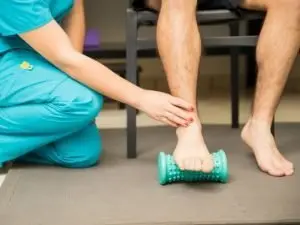
If you have experienced plantar fasciitis symptoms for fewer than six months, you most likely have acute plantar fasciitis. If your symptoms have persisted for more than six months, there is a high likelihood that you have chronic plantar fasciitis.
Plantar fasciitis treatments range from conservative therapies, such as icing and rest, to surgery or a non-invasive High-energy Extracorporeal Shockwave Therapy treatment.
For most acute plantar fasciitis sufferers, conservative treatments and rest usually work. Most people start with rest and nonsteroidal anti-inflammatory drugs (NSAIDs), such as ibuprofen or aspirin, to decrease inflammation and reduce pain. A steroid injection can also reduce inflammation and relieve pain, but multiple injections may weaken the fascia and cause additional damage.
Other treatments include physical therapy and night splints to stretch and strengthen your fascia. Orthotics may help provide support and evenly distribute pressure on your foot. A change of footwear to shoes that provide cushioning and support to the foot is often necessary.
Of course, decreasing your body weight and modifying activities to reduce your fascia stress are also recommended. When conservative treatments fail and you have chronic plantar fasciitis, your doctor may recommend plantar fasciotomy surgery or non-invasive Extracorporeal Shockwave Therapy treatment.
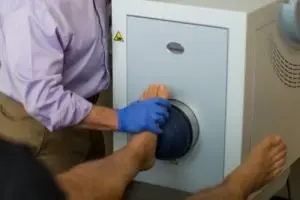
Conservative treatments may help reduce symptoms of chronic plantar fasciitis, but sometimes the fascia is too degenerated. Your doctor may recommend plantar fasciotomy surgery where the fascia is partially cut to release the tension. You also have a non-invasive option.
OrthoWave® is an FDA approved High-energy Extracorporeal Shockwave Therapy (HeSWT) treatment and a non-invasive alternative to surgery. Only a single session of OrthoWave® is needed, and there is no downtime after your treatment, unlike surgery. Since 2010, HeSWT is recommended over the surgery by the College of Foot and Ankle Surgeons because it is exceptionally safe and highly effective.
Plantar fasciitis is painful and can affect every aspect of your life. Hopefully, this has helped you better understand the symptoms, causes, diagnosis and some treatment options. Plantar fasciitis may be common, but it is also preventable. Listen to your body and take care of your feet to reduce your risk of getting this painful condition. You do not have to live with the pain of plantar fasciitis as there are numerous treatment options to get you back on your feet and doing the things you love again pain free.
Based In Science, Elevated by Service By Vessel Crew Vessel’s passion for improving the lives of others is anchored in an enthusiasm for science and its basis in wellness. Since our founding,…
NADH, NAD+, And NAD Benefits, Side Effects, Dosage And Stacking By Vessel Crew Let’s learn a little about this co-enzyme called NAD. It can be referred to as NADH, NAD+, NAD, vitamin…
©2024 Vessel Longevity + IV Bar ATX